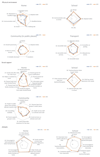How available to European children and young people with cerebral palsy are features of their environment that they need?
- PMID: 28987966
- PMCID: PMC5679358
- DOI: 10.1016/j.ridd.2017.09.018
How available to European children and young people with cerebral palsy are features of their environment that they need?
Abstract
Background: The UN Convention on the Rights of Persons with Disabilities requires accessibility to the physical and social environments. However, individuals with cerebral palsy (CP) have many difficulties in accessing the environment they need for functional independence and social inclusion.
Aims: To examine the availability of environmental features which children with CP need for optimal participation, and whether availability changed for them between ages 8-12 and 13-17 years.
Methods: The sample is the 594 children with CP, born 31/07/1991-01/04/1997, who took part in the SPARCLE study at age 8-12 (SPARCLE 1) and again at 13-17 years (SPARCLE 2). Participants were randomly sampled from population registers of children with CP in eight European regions; one further region recruited from multiple sources. Data about environment were captured with the European Child Environment Questionnaire (60 items). Differences in availability of environmental features between childhood and adolescence were assessed using McNemar's test; differences between regions were assessed by ranking regions. Differences in availability between regions were assessed by ranking regions.
Results: For seven environmental features significantly (p<0.01) fewer individuals needed the feature in SPARCLE 2 than in SPARCLE 1, whilst for two features more individuals needed the feature. Nine features in SPARCLE 1 and six features in SPARCLE 2 were available to less than half the participants who needed them. Eight features showed significantly (p<0.01) higher availability in SPARCLE 2 than in SPARCLE 1 (enlarged rooms, adapted toilet, modified kitchen and hoists at home, adapted toilets and lifts at school, an adequate vehicle, grants for home modifications) while none showed significantly lower availability. The relative rankings of the better and less good regions persisted from the age 8-12year age group to the 13-17year age group.
Conclusions: Needed environmental features are unavailable to many children at ages 8-12 and 13-17 years. This lack of availability is more pronounced in some regions than others, which probably results from their policy, legislative and statutory frameworks.
Keywords: Adolescence; Cerebral palsy; Childhood; Disability; Environmental features.
Copyright © 2017 Elsevier Ltd. All rights reserved.
Conflict of interest statement
The authors declare that they have no conflicts of interest.
Figures
Similar articles
-
Environmental needs and facilitators available for children and adolescents with cerebral palsy: adaptation and validation of the European Child Environment Questionnaire (ECEQ) Spanish version.Disabil Rehabil. 2014;36(18):1536-48. doi: 10.3109/09638288.2013.847124. Epub 2013 Oct 28. Disabil Rehabil. 2014. PMID: 24164566
-
Determinants of participation and quality of life of young adults with cerebral palsy: longitudinal approach and comparison with the general population - SPARCLE 3 study protocol.BMC Neurol. 2021 Jun 30;21(1):254. doi: 10.1186/s12883-021-02263-z. BMC Neurol. 2021. PMID: 34193065 Free PMC article.
-
Assessing the Adequacy of the Physical, Social, and Attitudinal Environment to the Specific Needs of Young Adults With Cerebral Palsy: The European Adult Environment Questionnaire.Arch Phys Med Rehabil. 2024 May;105(5):906-920. doi: 10.1016/j.apmr.2023.11.012. Epub 2024 Jan 11. Arch Phys Med Rehabil. 2024. PMID: 38206241
-
Rehabilitation service utilization in children and youth with cerebral palsy.Child Care Health Dev. 2014 Mar;40(2):275-82. doi: 10.1111/cch.12026. Epub 2013 Jan 30. Child Care Health Dev. 2014. PMID: 23363242 Review.
-
Housing Spaces in Nine European Countries: A Comparison of Dimensional Requirements.Int J Environ Res Public Health. 2021 Apr 17;18(8):4278. doi: 10.3390/ijerph18084278. Int J Environ Res Public Health. 2021. PMID: 33920693 Free PMC article. Review.
Cited by
-
Assessment of Manual Abilities Using the Box and Block Test in Children with Bilateral Cerebral Palsy.Occup Ther Int. 2022 Feb 22;2022:9980523. doi: 10.1155/2022/9980523. eCollection 2022. Occup Ther Int. 2022. PMID: 35281716 Free PMC article.
References
-
- Altman D. Practical statistics for medical research. London: Chapman & Hall; 1990.
-
- Anaby D, Hand C, Bradley L, DiRezze B, Forhan M, DiGiacomo A, et al. The effect of the environment on participation of children and youth with disabilities: A scoping review. Disability and Rehabilitation. 2013;35:1589–1598. - PubMed
-
- Anaby D, Law M, Majnemer A, Feldman D. Opening doors to participation of youth with physical disabilities: An intervention study: Favoriser la participation des adolescents ayant des handicaps physiques: Étude d’intervention. Canadian Journal of Occupational Therapy. 2016;83:83–90. - PubMed
MeSH terms
Grants and funding
LinkOut - more resources
Full Text Sources
Other Literature Sources
Medical
Miscellaneous


